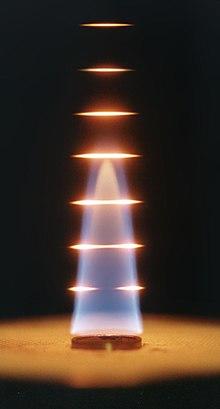Thin filament pyrometry (TFP) is an optical method used to measure temperatures. It involves the placement of a thin filament in a hot gas stream. Radiative emissions from the filament can be correlated with filament temperature. Filaments are typically silicon carbide (SiC) fibers with a diameter of 15 micrometres. Temperatures of about 800–2500 K can be measured.
History
TFP was first used by V. Vilimpoc and L.P. Goss (1988). A recent paper using TFP is Maun et al. (2007).
Technique
The typical TFP apparatus consists of a flame or other hot gas stream, a filament, and a camera.
Advantages
TFP has several advantages, including the ability to simultaneously measure temperatures along a line and minimal intrusiveness. Most other forms of pyrometry are not capable of providing gas-phase temperatures.
Drawbacks
Calibration is required. Calibration typically is performed with a thermocouple. Both thermocouples and filaments require corrections in estimating gas temperatures from probe temperatures. Also, filaments are fragile and typically break after about an hour in a flame.
Applications
The primary application is to combustion and fire research.
See also
- ASTM Subcommittee E20.02 on Radiation Thermometry
References
- L.G. Blevins, M.W. Renfro, K.H. Lyle, N.M. Laurendeau, J.P. Gore, Experimental study of temperature and CH radical location in partially premixed CH4/air coflow flames , Combustion and Flame 118 (4) 684-696 (1999).
- J.D. Maun, Thin-Filament Pyrometry With a Digital Still Camera, M.S. Thesis, University of Maryland (2006).
- J.D. Maun, Peter B. Sunderland, D.L. Urban, Applied Optics, 46:483-488 (2007).
- W.M. Pitts, Proceedings of the Combustion Institute 26:1171-1179 (1996).
- V. Vilimpoc, L.P. Goss, Proceedings of the Combustion Institute 22:1907-1914 (1988).
